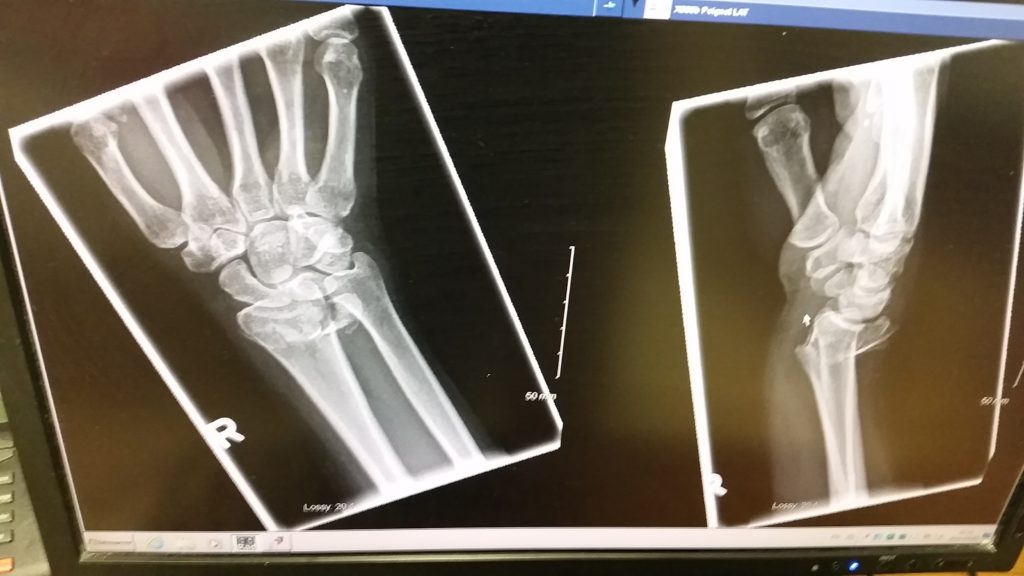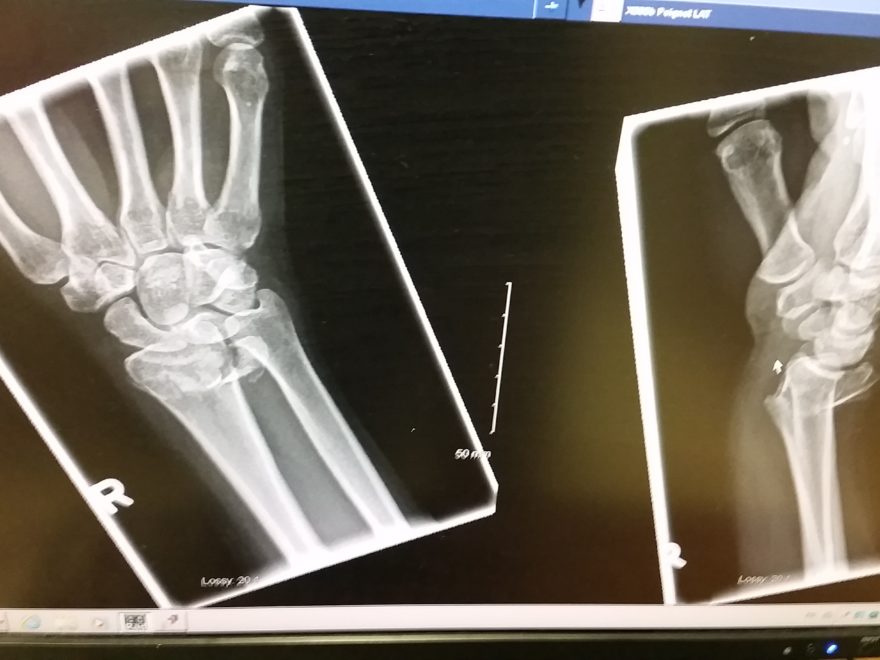In late winter of 2016, I slipped on a patch of ice and broke my arm. I fell hard onto my right hand and hip, so consider myself lucky not to have broken my hip. That said, I snapped the radius clear through.
I’m right-handed, so of course I broke my right arm. The next part of this story won’t surprise anyone who knows me… I could see that the bone was broken, but neither edge had broken the skin. So what did I decide to do?
Drive myself home! It seemed like a good idea, at the time. It was obvious to me that my arm was going to end up in a cast, but I was wearing my favourite suit and didn’t want it to be ruined by plaster from a cast.
Besides, home was fairly close to the hospital. So it made sense – to me – to head home before going to the hospital. It would have taken much longer for my husband to come get me – and then drive all the way back towards home – to bring me to the hospital.
Based on my years-ago military first aid training, it was a clean break. And although the pain was bad, it was tolerable. So I drove home, and stopped at a doughnut shop to get coffee. It was late evening, and I figured we’d be at the hospital for a while. And that my husband might be dozing on the sofa when I got home.
I parked the car at the coffee shop, pulled some cash out of my purse with my left hand, went inside, waited in line, got an extra-large coffee, walked back to the car, and drove the rest of the way home. With a broken arm.
I’d loosely wrapped my arm in a scarf, to avoid scaring anyone at the coffee shop, so the fracture wasn’t immediately obvious when I got home:
- Me: “Uh, sweetie, I need you to help me change and then drive me to the hospital”, while unwrapping the scarf from my right arm
- Him: Glancing over at me, while stirring milk into his coffee, “Why do you need to…? Oh no… HOW did you…? You DROVE home?!!… You stopped for COFFEE?!?”
My still-surprised husband very carefully helped me change into some comfy old clothes, and we headed over to the local community hospital. He drove, this time! We live in Canada, so we can walk into any hospital in our province and be treated at no cost. Well, aside from parking fees at some hospitals.
I’ll write about taxpayer-funded (almost) universal healthcare another day, as my field is bioethics (sometimes called medical ethics). For this post it’s only relevant in that we didn’t have to worry about treatment costs, or about whether this hospital would accept our insurance.
We chose to go to our local community hospital because it was ‘just’ a broken arm. Montreal is home to several universities, as well as two different medical schools, so we have an abundance of good university hospitals. They’re all much farther from our home, so at this point we opted for the shortest drive.
I was triaged fairly quickly, and the emergency physician on duty was both efficient and kind. I view the latter as one of the most important attributes in a healthcare professional. The former is a runner-up.
One of the nurses assisting the physician took a horrified look at my husband, calmly drinking the take-out coffee I’d picked up on my way home. She blurted out: “Her arm looks like THAT, and you stopped for coffee?!”
He explained that I’d driven myself home, and had stopped to get coffee because I knew – from having worked at another hospital, years ago – that the coffee in the waiting room would be horrid. She didn’t disagree ‘-)
The physician then asked my husband to leave the room while she examined m. She and the nurse went through a protocol, to check whether I’d been a victim of domestic violence. This is important in healthcare settings, because research in 2011 showed that over 75% of:
domestic violence victims who report the incidents to police seek health care in emergency rooms, but most of them are never identified as being victims of abuse during their hospital visit”.(1)
That wasn’t the case for me, but I told them both how pleased I was – from a bioethics perspective – to see that this suburban community hospital had a protocol in place to address domestic violence.
It was a quiet evening in a small hospital, so the clinical grapevine had already kicked in by the time we made our way over to the radiology department. When we arrived, the technicians were already calling me “the coffee lady” and joking with me that I’d forgotten their donuts. Which, of course, led to a conversation about the best types of doughnuts while they were taking my X-rays.
The jokes continued with them later, when I returned for additional X-rays after the fracture had been reset and the cast had been put on my arm. By this time I’d twisted a paper towel into a doughnut shape for them ‘-)

Even when I’m in a difficult situation, or in pain, I tend to be lighthearted and upbeat. In some ways, humour definitely helps me get through difficult times, but I had no idea yet of just how difficult things were going to get.
When I was first brought into the emergency department after triage, I’d offered a bet that my fractured arm was really just sprained… no one took me up on that bet – but it did get a lot of laughs from that tired-looking evening shift!
By the time we left the hospital about 4 hours later I’d been diagnosed with a snapped radius near the wrist, a Colles’ fracture. My right arm had been encased in an old-fashioned plaster cast, from above the knuckles to the elbow.
While the emergency physician had been evaluating me, she’d noticed that I was looking at the initial X-rays on the desk across from us. She had happily explained what I was seeing, pointing out the clean fracture. Before I left, she made a point of showing me the initial and reset X-rays – side by side.
The bone was now perfectly lined up, and she told me it should heal properly. That was way she had applied the cast on my arm herself, to be sure that the reset bone didn’t move during this process.
I left with a prescription for a few days worth of painkillers, and a referral to the hospital’s orthopedics department for follow-up. The bone healed well, and that should have been the end of this story. It wasn’t, but I’m not up to writing about that yet…
References:
(1) The Perelman School of Medicine. Three In Four Domestic Violence Victims Go Unidentified In Emergency Rooms, Penn Study Shows. News Release. 16 Mar 2011. Web.
https://www.pennmedicine.org/news/news-releases/2011/march/three-in-four-domestic-violen

